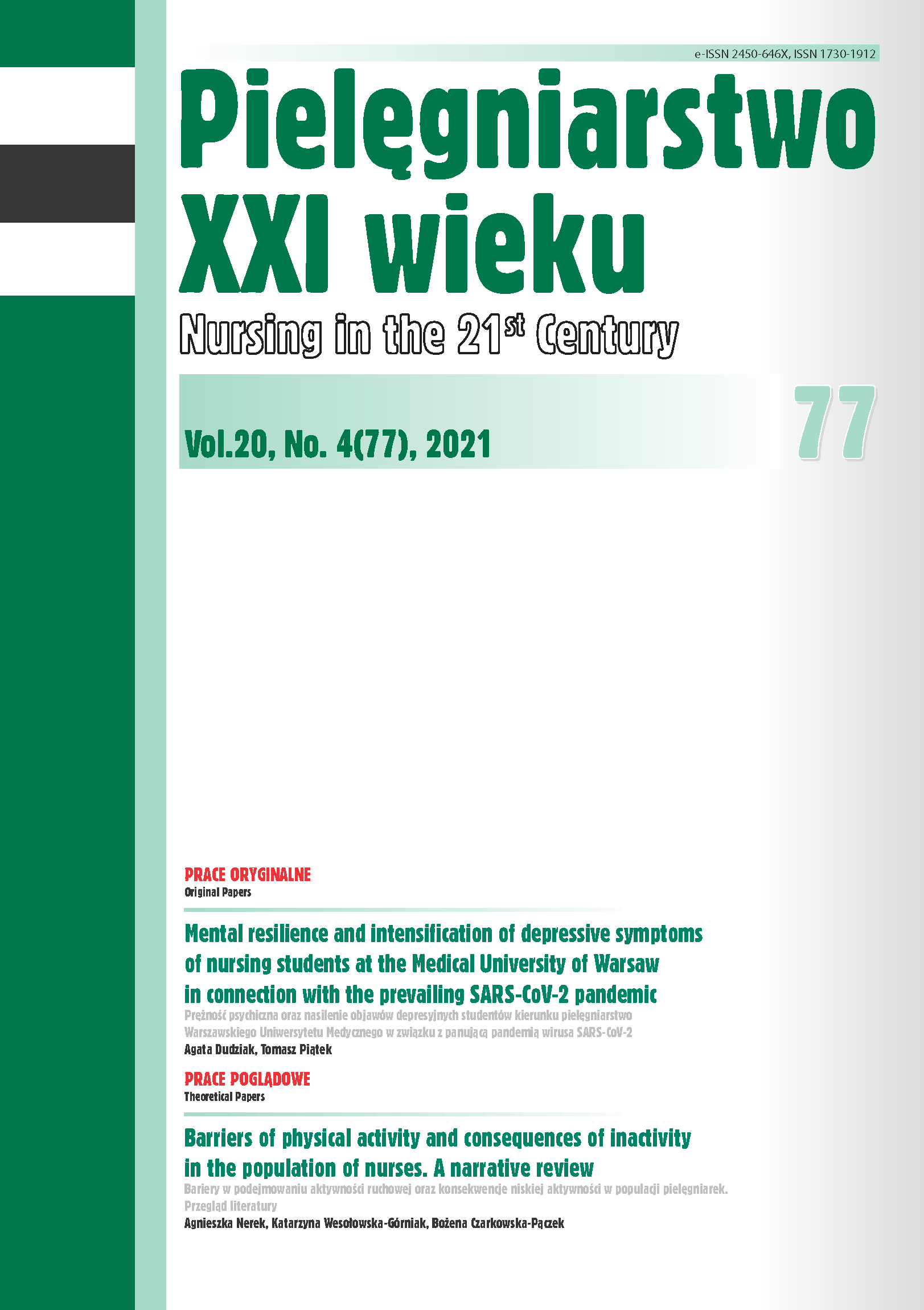Emotions at nurse`s work – non-systematic literature review
DOI:
https://doi.org/10.2478/pielxxiw-2021-0037Keywords:
emotional intelligence, social competences, emotional labourAbstract
EMOTIONS AT NURSE`S WORK – NON-SYSTEMATIC LITERATURE REVIEW
Introduction. The performance of any job requires the expression of adequate emotions that are consistent with the roles assigned to a given position. This fact has led to an enormous interest in methods of expression and concealing emotions, especially in management, business, education and healthcare.
Aim. Discussion of the infl uence of emotional intelligence and emotional labour on the work of a nurse.
Material and methods. Literature databases were reviewed using the key words: “intelligence”, “emotional intelligence”, “emotional labour” and in combination with the word “nursing”.
Discussion. Emotional intelligence is critical to the quality of patient care. Nurses make an additional psychological eff ort that contributes to their professionalism and effectiveness, which is referred to as “emotional labour”. Due to the way this work is performed, two its types have been distinguished: “surface acting” and “deep acting”. The effects of both types of emotional labour differ signifi cantly in favor of deep acting.
Conclusions. The relationships between nurses’ involvement in emotional labour and the quality of nursing services were found. However, little is known about how the emotional labour affects their own health, professional career or job satisfaction. Further research should be able to provide answers to these questions.
References
1. Strelau J, Brzeziński J. red. Psychologia różnic indywidualnych. Warszawa: Wydawnictwo Naukowe Scholar; 2002.
2. Strelau J. red. Psychologia ogólna. Gdańsk: Gdańskie Wydawnictwo Psychologiczne; 2004.
3. Goleman D. Working with emotional intelligence. Bantam; 1998.
4. Husin W, Santos A, Ramos HM, Nordin MS. The place of emotional intelligence in the ‚intelligence’ taxonomy: Crystallized intelligence or fluid intelligence factor? 9th International Conference on Cognitive Science. 2013; 97: 214-223.
5. Goleman D. Inteligencja emocjonalna. Sukces w życiu zależy nie tylko od intelektu, lecz od umiejętności kierowania emocjami. Poznań; Wyd. Media Rodzina; 2012.
6. Salovey P, Brackett MA, Mayer JD. Models of emotional intelligence. Emotional intelligence: Key readings on the Mayer and Salovey model, Ed. RJ Sternberg, New York; 2000: p. 81-119.
7. Salovey P, Grewal D. The science of emotional intelligence. Curr. Dir. Psychol. Sci. 2016; 14(6): 281-285.
8. Dziedzic B, Sienkiewicz Z, Kryczka T, Koper D. Hanna Chrzanowska prekursorka polskiego pielęgniarstwa rodzinnego – świadectwo jej życia. Piel. Pol. 2020; 75(1): 72-76.
9. Magpantay-Monroe ER. Exploring the emotional intelligence of Florence Nightingale. Asia Pac. J. Oncol. Nurs. 2015; 2(2): 107-111.
10. Bulmer Smith K, Profetto-McGrath J, Cummings GG. Emotional intelligence and nursing: an integrative literature review. Int. J. Nurs. Stud. 2009; 46(12): 1624-1636.
11. Regulation of the Minister of Science and Higher Education of 26 July 2019 on training standards for the professions of a doctor, dentist, pharmacist, nurse, midwife, laboratory diagnostician, physiotherapist and paramedic (Journal of Law 2019, pos. 1573). https://isap.sejm.gov.pl/isap.nsf/DocDetails.xsp?id=WDU20190001573 https://isap.sejm.gov.pl/isap.nsf/download.xsp/WDU20190001573/O/D20191573. pdf (accessed on 10.04.2021).
12. Han SS, Han JW, Kim YH. Effect of Nurses’ Emotional Labor on Customer Orientation and Service Delivery: The Mediating Effects of Work Engagement and Burnout. Saf. Health Work. 2018; 9(4): 441-446.
13. Huynh T, Alderson M, Thompson M. Emotional labour underlying caring: an evolutionary concept analysis. J. Adv. Nurs. 2008; 64(2): 195-208.
14. Huynh T, Alderson M, Nadon M, Kershaw-Rousseau S. Voices that care: licensed practical nurses and the emotional labour underpinning their collaborative interactions with registered nurses. Nurs. Res. Pract. 2011; DOI: 10.1155/2011/501790.
15. Nicky J. Care = organisation + physical labour + emotional labour. Sociol Health Ill. 1992; 14(4).
16. Smith P, Gray B. Reassessing the concept of emotional labour in student nurse education: role of link lecturers and mentors in a time of change. Nurse Educ. Today. 2001; 21(3): 230-237.
17. Grandey AA. Emotional regulation in the workplace: A new way to conceptualize emotional labor. J. Occup. Health Psychol. 2000; 5(1): 95-110.
18. Finogenow M, Wrobel M, Mroz J. Deep Acting and Surface Acting Scale (DASAS)Adaptation of the metod and preliminary psychometric properties. Med. Pr. 2015; 66(3): 359-371.
19. Hochschild AR. The managed heart: Commercialization of human feeling, by Arlie Russell Hochschild. Ed. University of California Press; Berkeley, CA; 1983.
20. Yang FH, Chang CC. Emotional labour, job satisfaction and organizational commitment amongst clinical nurses: a questionnaire survey. Int. J. Nurs. Stud. 2008; 45(6): 879-887.
21. Brotheridge CM, Grandey AA. Emotional Labor and Burnout: Comparing Two Perspectives of “People Work”. J. Vocat. Behav. 2002; 60(1): 17-39.
22. Szczygieł D, Kadzikowska-Wrzosek R, Retowski S. Praca emocjonalna w zawodach usługowych – pojęcie, przegląd teorii i badań. Psychol. Społ. 2009; 4 3(11): 155-166.
23. Gray B, Smith P. Emotional labour and the clinical settings of nursing care: the perspectives of nurses in East London. Nurse Educ. Pract. 2009; 9(4): 253-261.
24. Grandey A, Foo SC, Groth M, Goodwin RE. Free To Be You and Me: A Climate of Authenticity Alleviates Burnout From Emotional Labor. J. Occup. Health Psychol. 2012; 17(1): 1-14.
25. Kinman G, Leggetter S. Emotional Labour and Wellbeing: What Protects Nurses? Healthcare (Basel). 2016; 4(4): 89; DOI: 10.3390/healthcare4040089.
26. Roh CY, Moon MJ, Yang SB, Jung K. Linking Emotional Labor, Public Service Motivation, and Job Satisfaction: Social Workers in Health Care Settings. Soc. Work Public. Health. 2016; 31(2): 43-57.
27. Mikolajczak M, Menil C, Luminet O. Explaining the protective effect of trait emotional intelligence regarding occupational stress: Exploration of emotional labour processes. J. Res. Pers. 2007; 41(5): 1107-1117.
28. Kodeks Etyki Zawodowej Pielęgniarki i Położnej (Code of Professional Ethics for Nurses and Midwives). https://nipip.pl/prawo/samorzadowe/krajowy-zjazdpielegniarek-i-poloznych/kodeks-et yki-zawodowej-pielegniarki-i-poloznejrzeczypospolitej-polskiej/ (accessed on 10.04.2021)
29. Theodosius C. Emotional labour in health care. The unmanaged heart of nursing. Ed. Routledge Taylor & Francis Group; New York (NY); 2008.
Downloads
Published
Issue
Section
License
Copyright (c) 2021 Authors

This work is licensed under a Creative Commons Attribution-NonCommercial-NoDerivatives 4.0 International License.




